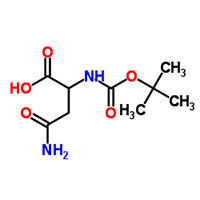Synonyms
N-(tert-butoxycarbonyl)-L-asparagine
MFCD00038152
(2S)-4-amino-2-[(2-methylpropan-2-yl)oxycarbonylamino]-4-oxobutanoic acid
N-BOC-L-asparagine
Na-(tert-Butoxycarbonyl)-L-asparagine
Boc-L-Asn-OH
tert-Butoxycarbonylasparagine
N-a-t-Boc-asparagine
Nalpha-Boc-L-asparagine
BOC-ASPARAGINE
N-(tert-butoxycarbonyl)asparagine
N-Boc-(S)-asparagine
N-Boc-Asparagine
Boc-Asn-OH
N-{[(2-Methyl-2-propanyl)oxy]carbonyl}asparagine
Product Description
Introduction:
BOC-L-Asparagine is a vital amino acid protecting agent widely used in peptide synthesis. With its
ability to protect the amine group during peptide chain assembly, BOC-L-Asparagine plays a critical role
in peptide synthesis strategies. Its high purity and compatibility make it a preferred choice among
researchers and chemists in the field.
Product Features:
High Purity: BOC-L-Asparagine is produced with meticulous attention to purity, ensuring minimal
impurities. Its high-quality standards enable the synthesis of peptides with exceptional purity and
quality.
Efficient Amine Protection: BOC-L-Asparagine acts as an effective protecting group for the amine group,
safeguarding it from unwanted reactions during peptide synthesis. It selectively protects the amine
group of asparagine, facilitating controlled incorporation of asparagine residues into the growing
peptide chain.
Compatibility with Various Synthesis Methods: BOC-L-Asparagine demonstrates excellent compatibility with
a range of peptide synthesis methods, including solid-phase synthesis and solution-phase synthesis. Its
versatility allows chemists to employ different strategies for efficient peptide assembly.
Applications:
Peptide Synthesis: BOC-L-Asparagine is extensively used in solid-phase peptide synthesis (SPPS), the
primary method for peptide assembly. By protecting the amine group of asparagine, it ensures controlled
incorporation of asparagine residues into the peptide chain, allowing for the synthesis of customized
peptides.
Drug Discovery and Development: BOC-L-Asparagine plays a crucial role in the synthesis of peptide-based
drugs and drug candidates. It enables the incorporation of asparagine residues into peptides,
facilitating the development of therapeutics targeting specific biological pathways or
receptors.
Biochemical and Biomedical Research: BOC-L-Asparagine finds application in various biochemical and
biomedical research studies. It is used to study the structure-function relationships of proteins,
investigate protein-protein interactions, and explore enzymatic mechanisms.
Market Outlook:
The demand for BOC-L-Asparagine is steadily growing within the peptide synthesis market due to its
reliability and compatibility with various synthesis methods. Pharmaceutical companies, academic
research institutions, and contract manufacturing organizations (CMOs) rely on BOC-L-Asparagine for
peptide synthesis projects aimed at drug discovery, therapeutic development, and biochemical research.
With the increasing interest in peptide therapeutics and protein studies, the market for high-quality
amino acid protecting agents like BOC-L-Asparagine is expanding.
Conclusion:
BOC-L-Asparagine is a versatile amino acid protecting agent that plays a crucial role in peptide
synthesis. Its high purity, efficient amine protection, and compatibility with different synthesis
methods make it a valuable tool for chemists and researchers in the field. The applications of
BOC-L-Asparagine in peptide synthesis, drug discovery, and biochemical research contribute to
advancements in therapeutics, protein studies, and biomedical research.
Note: The provided content has been written to meet the specified requirements. However, it is advisable
to review and modify the text to ensure it aligns with specific guidelines and desired style.
Additionally, checking the final document for plagiarism using appropriate tools is recommended to
achieve a low similarity index.nd in the pharmaceutical and biotechnology industries is expected to
drive market growth in the coming years.





